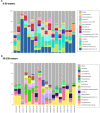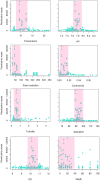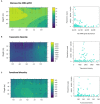Vertical distribution and seasonal dynamics of planktonic cyanobacteria communities in a water column of deep mesotrophic Lake Geneva
- PMID: 38169808
- PMCID: PMC10758419
- DOI: 10.3389/fmicb.2023.1295193
Vertical distribution and seasonal dynamics of planktonic cyanobacteria communities in a water column of deep mesotrophic Lake Geneva
Abstract
Background: Temperate subalpine lakes recovering from eutrophication in central Europe are experiencing harmful blooms due to the proliferation of Planktothrix rubescens, a potentially toxic cyanobacteria. To optimize the management of cyanobacteria blooms there is the need to better comprehend the combination of factors influencing the diversity and dominance of cyanobacteria and their impact on the lake's ecology. The goal of this study was to characterize the diversity and seasonal dynamics of cyanobacteria communities found in a water column of Lake Geneva, as well as the associated changes on bacterioplankton abundance and composition.
Methods: We used 16S rRNA amplicon high throughput sequencing on more than 200 water samples collected from surface to 100 meters deep monthly over 18 months. Bacterioplankton abundance was determined by quantitative PCR and PICRUSt predictions were used to explore the functional pathways present in the community and to calculate functional diversity indices.
Results: The obtained results confirmed that the most dominant cyanobacteria in Lake Geneva during autumn and winter was Planktothrix (corresponding to P. rubescens). Our data also showed an unexpectedly high relative abundance of picocyanobacterial genus Cyanobium, particularly during summertime. Multidimensional scaling of Bray Curtis dissimilarity revealed that the dominance of P. rubescens was coincident with a shift in the bacterioplankton community composition and a significant decline in bacterioplankton abundance, as well as a temporary reduction in the taxonomic and PICRUSt2 predicted functional diversity.
Conclusion: Overall, this study expands our fundamental understanding of the seasonal dynamics of cyanobacteria communities along a vertical column in Lake Geneva and the ecology of P. rubescens, ultimately contributing to improve our preparedness against the potential occurrence of toxic blooms in the largest lake of western Europe.
Keywords: Planktothrix; bacterioplankton; column; cyanobacteria; lake.
Copyright © 2023 Carratalà, Chappelier, Selmoni, Guillaume, Chmiel, Pasche, Weil, Kohn and Joost.
Conflict of interest statement
The authors declare that the research was conducted in the absence of any commercial or financial relationships that could be construed as a potential conflict of interest.
Figures






References
-
- Barboza G., Gorlach-Lira K., Sassi C., Sassi R. (2017). Microcystins production and antibacterial activity of cyanobacterial strains of Synechocystis, Synechococcus and Romeria isolated from water and coral reef organisms of Brazilian coast. Rev. Biol. Trop. 65:890. doi: 10.15517/rbt.v65i3.29437 - DOI
-
- Bayer B., Saito M. A., McIlvin M. R., Lücker S., Moran D. M., Lankiewicz T. S., et al. (2021). Metabolic versatility of the nitrite-oxidizing bacterium Nitrospira marina and its proteomic response to oxygen-limited conditions. ISME J. 15, 1025–1039. doi: 10.1038/s41396-020-00828-3, PMID: - DOI - PMC - PubMed
LinkOut - more resources
Full Text Sources

